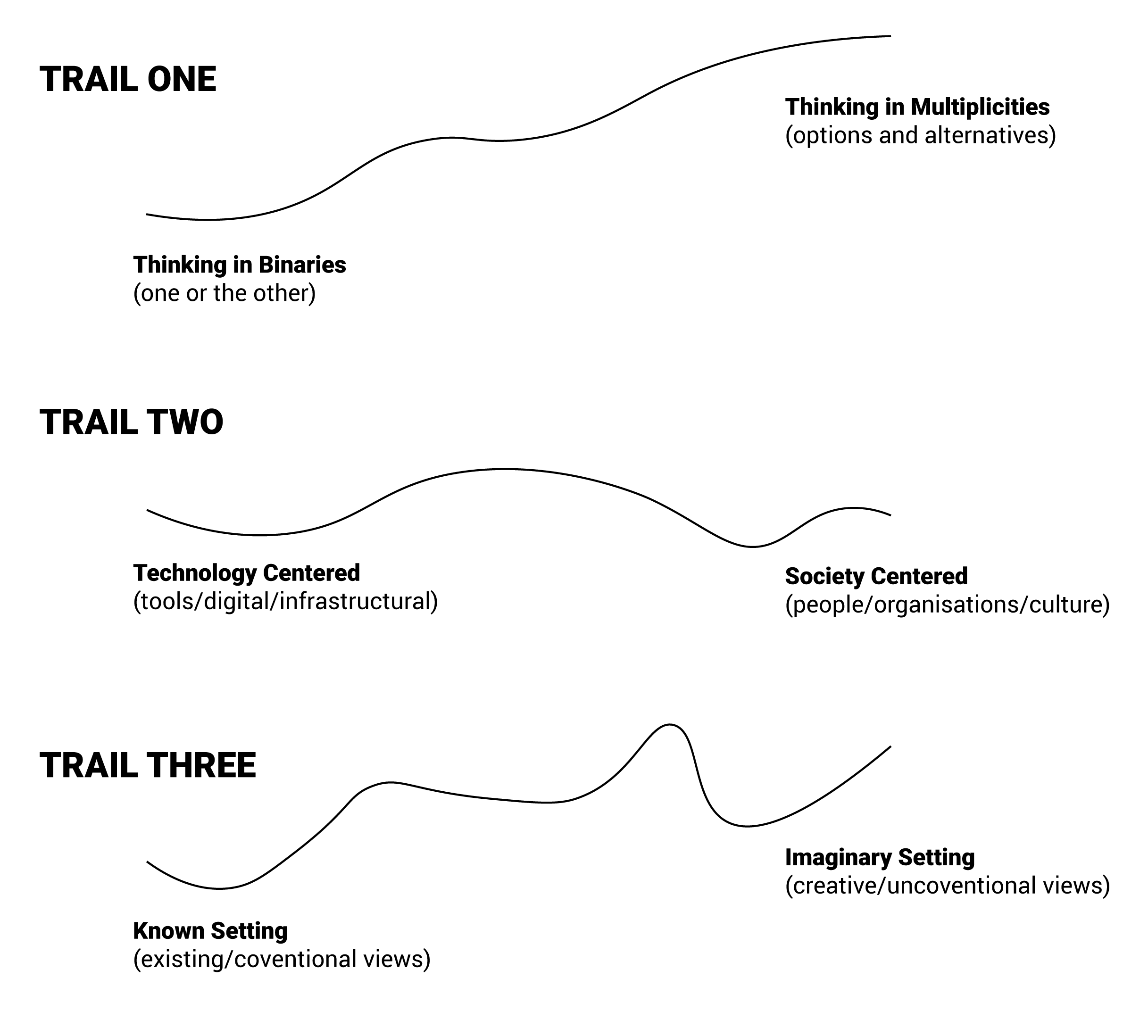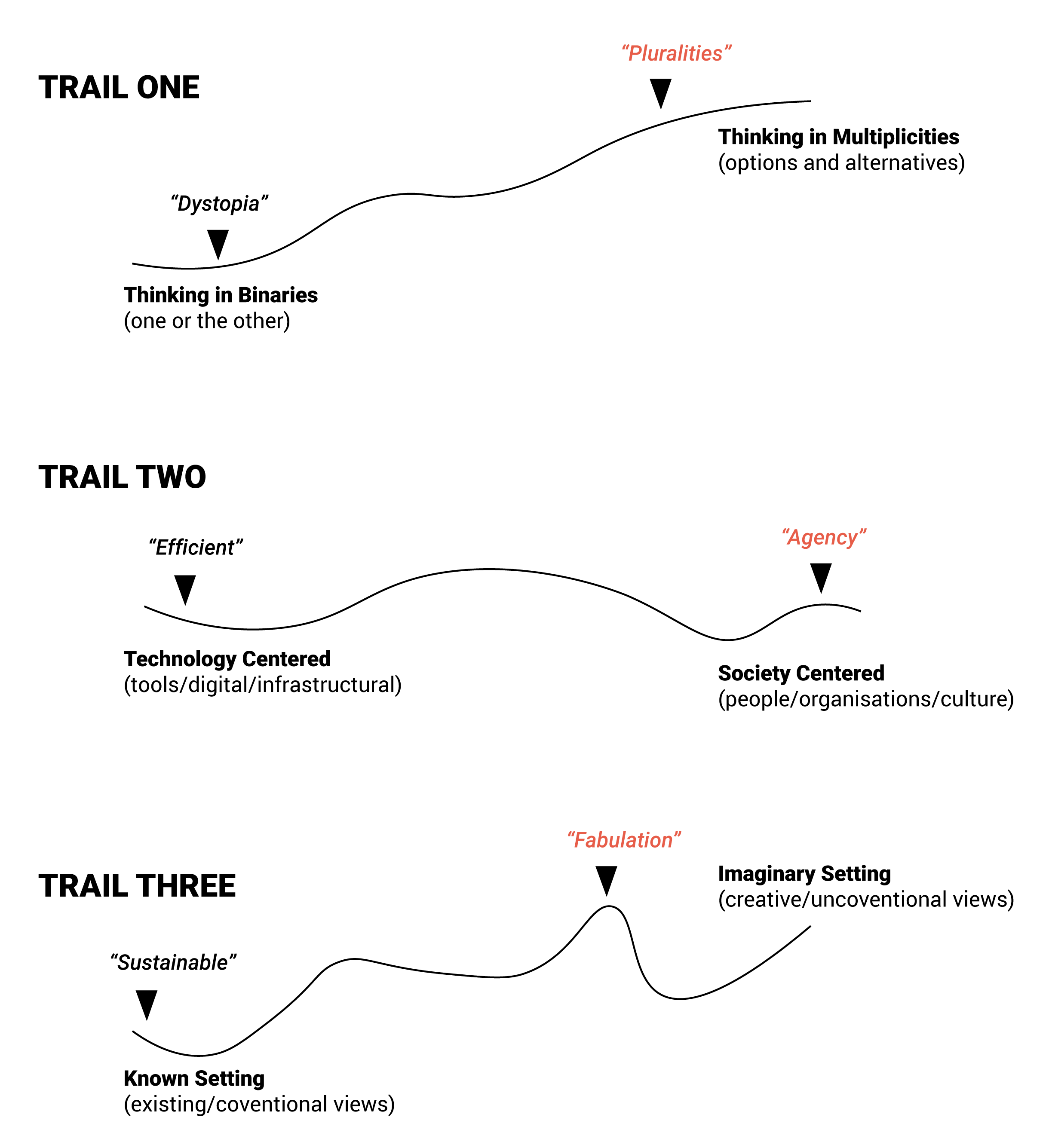UNIT 6.1.
FUTURES DESIGN WORDS AND IMAGES
FUTURES DESIGN WORDS AND IMAGES
AIMS
This activity aims to:
- introduce relations between words, images and futures
- provide connection between futures design words and related imaging
- open out for image annotation, future mapping and multimodality
- suggest strategies and techniques for shaping futures verbal-visual design
TIME
1 hour
1. INTRODUCTION
While this Lexicon focuses on words and design, relationships between words and images are central to design communication. When we work with futures design and speculative projects there’s also a need to be vigilant about the ways words are used to annotate, describe, explain, interpret and critique visualisations of futures.
Equally, words themselves may be given context, specific character and definition by the styles and types of visualisations produced. It’s important that you recall other classes and projects where you have been involved in building and clarifying relations between visual aspects of design and their spoken and written texts.
2. INTRODUCING RELATIONS BETWEEN WORDS, IMAGES AND FUTURES
In popular culture, future worlds, scenarios and daily life are often materialised in the form of science fiction writing and films. The futures depicted are often technology driven, dystopian and violent conflicts over power, resources and governance. With the odd alien invasion. These works challenge us to think ahead of our current settings but in many instances they reveal a good deal about how we do think and are able to construct worlds beyond those within which we work and play and also design.
For designers and designer-researchers our world making is often connected back to today to address pressing matters; yet it may also seek to break free of these and propose unexpected, surprising and even disruptive alternatives to current conventions and expectations. We need to look into how the future itself may be colonised by interests in the present; we ought to question persuasive technocratic, shiney futures that obscure other dynamics and interests. For design this means casting questioning eyes on the visual-verbal narratives that are presented and marketed and how these mediations are worded and expressed verbally and visually.
ACTIVITY #1: WHAT WORDS DO YOU USE TO DESCRIBE FUTURES?
1. Think about science fiction movies for a moment. Where in the future do you think you are? Is it a near future, in the next 5-10 years, or a far future, one much further away?
2. Either from your experience, or going online, select the trailers for two science fiction movies. Watch the two trailers. Are the films placed in the near or far future?
3. Make notes on any futures related words that stand out to you within these trailers. What are the words you’d use to describe the futures view in these trailers? Write 10-15 words in a list. We will call this list 1.
ACTIVITY #2: NEW WORDS, NEW VOCABULARY
1. Consult the 50 FUTURES DESIGN WORDS (Words only). Do you see new words you had not thought about before? Consult 50 FUTURES DESIGN WORDS (With definitions) or Google search any word you’re not familiar with.
2. Go back to the same two trailers. Watch them again.
3. Now reflect on the trailers, using the words present within the 50 FUTURES DESIGN WORDS (Words only). Do these words help you see more details present within the trailers? Which one these words you’d use to describe the futures view in these trailers? Make a list of 10-15 words. We will refer to this as list 2. Make sure you keep list 2 in a different colour.
ACTIVITY #3: TRAILS OF THE FUTURE
1. Look closely at the image below, what we call ‘Trails Map for Futures Design’. Print or copy the image on-screen, or draw it on a sheet of paper.
Trail #1: Thinking in Binaries to Thinking in Multiplicities
Trail #2: Technology Centered to Society Centered
Trail #3: Known Setting to Imaginary Setting

Figure 1: Trails Map for Futures Design.
2. Compare the two lists. List 1 contains your own words, written after watching the two trailers the first time. This represents the first associations made between visuals seen and language we use. List 2 contains words from the 50 FUTURES DESIGN WORDS (Words only), selected after watching the two trailers the second time. This allows for variety and nuance in expression that may not be present in list 1. Please note that words in list 2 are distinguished by being in a different colour.
3. Look at each trail one by one. Plot words from list 1 first. After that plot the words from list 2 on the trails. See Figure 2 as an example (the orange is to denote words from list 2).

Figure 2: The Plotting of List 1 and List 2. The orange denotes words from list 2.
ACTIVITY #4: REVISITING THE TRAILS
1. In a different colour, map new words, and words used in your summary on to the Trails Map.
2. Study the words you have chosen, and used in your writing, before and after looking at the 50 FUTURES DESIGN WORDS (Words only).
What similar words did you use? Did you use different words the second time? Why do you think this is so?
Draw loops between similar words and dotted lines between different one.
3. In your diagramming, what do you see as a ‘word trail’ between the trails, in your reference to and use of words, that is distance or proximity of the words you selected and have applied in your writing.
3. PROMOTING TECHNO FUTURES
In the previous section you looked at some popular cultural references to futures we all have encountered outside our design professions. That said, while they affect our sensibilities as designers, we also affect these sensibilities in return. When we designers conceive and express ideas about futures, from scenarios to pitches to clients, we are turning our ideas of what future might be, into the reality of what the future will actually be. The following activities will explore this further by taking the topic of ‘smart city’ as an example.
ACTIVITY #5: QUESTIONING THE ‘SMART CITY’
1. In the past 5-6 years, ‘smart cities’ has remained one of the hot topics of debate. While such a topic has traditionally been the purview of urbanists, in the recent years designers have become significant players within the ongoing conversation.
2. What are your associations with the topic ‘smart cities’? Write the first 10 words that come to your mind.
SEE MORE
Readings
Clarke, Michael. 2007. Verbalising the Visual. Lausanne: AVA Publishing.
Kress, Gunther, and Theo van Leeuwen. 1996. Reading Images: The Grammar of Visual Design. London: Routledge.
MacCabe, Colin, and Holly Yanacek. 2005. Keywords for Today: A 21st Century Vocabulary. Oxford: Oxford University Press.
Morrison, Andrew, Kjetil Nordby, Timo Arnall, and Even Westvang. 2015. “Breathing life into research mediation.” In Performing Digital: Multiple Perspectives on a Living Archive, edited by David Carlin and Laurene Vaughan, 161-184. London: Ashgate.
Tassarini, V. & Staszowski, E. (2020). (Eds.). Designing in Dark Times: An Arendtian Lexicon. London: Bloomsbury Academic.
Vervoort, Joost, Roy Bendor, Aisling Kelliher, Oscar Strik, and Ariella Helfgott. 2015. “Scenarios and the art of worldmaking.” Futures 74: 62-70.
Tools
Reference item.
Projects
Reference item.
Research
Reference item.
Modules
Reference item.
CONTRIBUTE TO THIS UNIT!
Future Education and Literacy for Designers (FUEL4Design) is an open project.
You are invited to contribute by presenting your own use of this UNIT as well as share feedback on this resource.
WHAT
An addition or comment to a UNIT or the use of an ESSENTIAL you see as appropriate.
WHY
Making a contribution will help connect the LEXICON to other work, innovations, settings and persons.
WHERE
Your contribution can be related to the content of the LEXICON, to the work you do or that of others.
HOW
Send your suggestions, cases, courses, projects and additions to: contactus@fuel4design.org